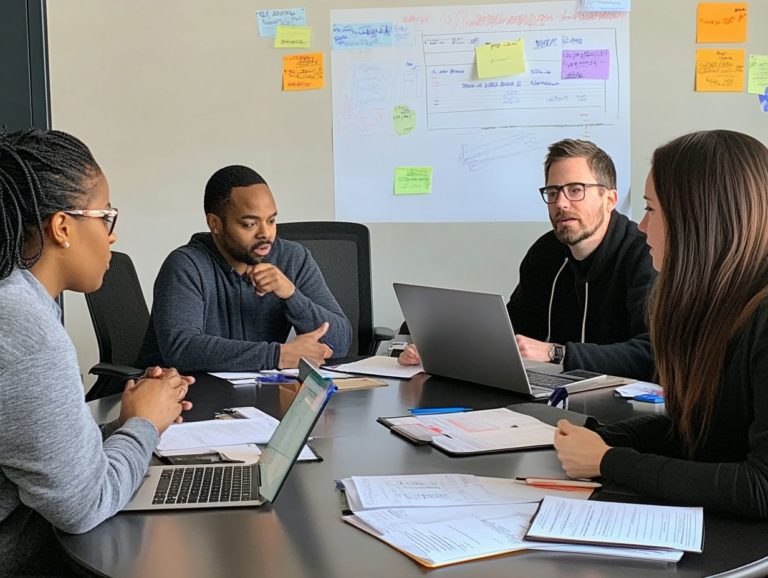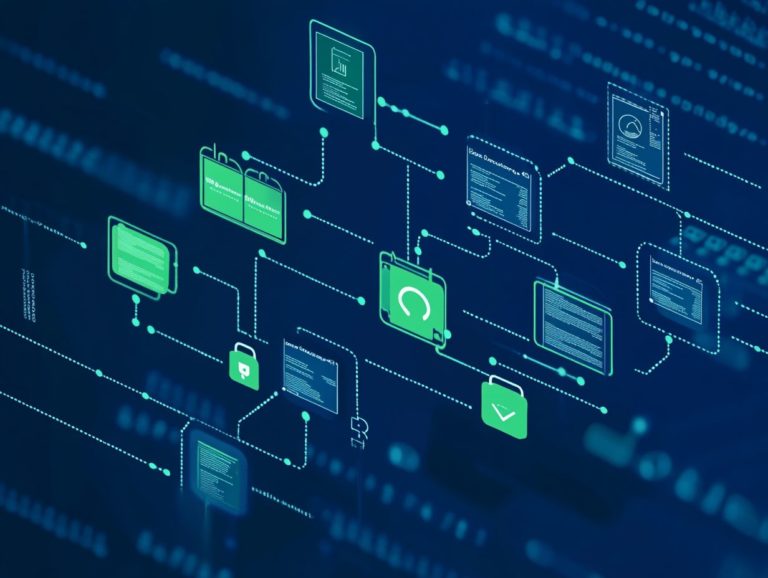how to use vulnerability assessment results for growth
In today s rapidly changing landscape, grasping the concept of vulnerability assessments is essential for both you and your organization.
This article delves into what vulnerability assessments entail and provides insights on how to interpret their results effectively. By pinpointing areas for improvement and crafting a strategic growth plan, you can harness these insights to elevate your performance.
We will guide you through implementing actionable changes, tracking your progress, and reaping the rewards of a more resilient and successful approach. Together, let s explore how to transform vulnerability into opportunity.
Contents
- Key Takeaways:
- Understanding Vulnerability Assessment Results
- Using Vulnerability Assessment Results for Growth
- Implementing Changes Based on Results
- Benefits of Using Vulnerability Assessment Results for Growth
- Frequently Asked Questions
- 1. What is a vulnerability assessment and why is it important for growth?
- 2. How can I interpret the results of a vulnerability assessment?
- 3. How often should vulnerability assessments be conducted for optimal growth?
- 4. Can vulnerability assessment results be used to improve business processes?
- 5. What steps should I take after receiving vulnerability assessment results?
- 6. How can I ensure ongoing growth with vulnerability assessment results?
Key Takeaways:

Vulnerability assessments provide valuable insight into potential weaknesses and risks that can hinder growth.
By identifying areas for improvement and developing a growth strategy, businesses can proactively address vulnerabilities and drive growth.
Implementing changes based on vulnerability assessment results can lead to improved performance, minimized risks, and help you achieve your growth goals, especially when you know what to include in your vulnerability assessment report.
Understanding Vulnerability Assessment Results
Understanding the key elements of a vulnerability assessment results is essential for organizations aiming to elevate their overall security status and safeguard their IT infrastructure against evolving threats.
A comprehensive vulnerability assessment reveals valuable insights into security weaknesses present in both software and hardware assets, enabling cybersecurity specialists to craft effective remediation plans.
This process involves vulnerability scanning, risk identification, and in-depth analysis of vulnerability data. It helps prioritize critical vulnerabilities while ensuring compliance with relevant regulations.
It also helps identify ways that attackers might exploit vulnerabilities, ultimately fostering a robust plan to manage vulnerabilities.
What is a Vulnerability Assessment?
- A vulnerability assessment evaluates your organization s security.
- It identifies security weaknesses in your network and systems.
- This process helps prioritize which vulnerabilities to fix first.
This essential process grants you a clear understanding of your weaknesses, enabling you to prioritize remediation efforts based on potential risks.
While the methodologies involved can vary, they typically encompass automated scanning tools, manual penetration testing, and risk analysis techniques. These strategies help uncover security gaps that malicious actors could exploit.
By integrating vulnerability management tools into your security strategy, you significantly enhance your ability to detect and respond to threats. Automating the identification and tracking of vulnerabilities enables your security teams to address issues swiftly, ultimately bolstering your overall security resilience.
Interpreting Results
Interpreting scan results from a vulnerability assessment requires you to analyze the identified security flaws and categorize them based on their severity and potential impact on your organization s operations and assets.
To effectively gauge the risk levels, you need to understand the context of each vulnerability, including how easily it can be exploited and the critical nature of the systems involved. Risk analysis is essential, as it allows you to prioritize remediation efforts by weighing the likelihood of an attack against the potential damage.
By leveraging threat intelligence, you can stay informed about emerging threats and trends, enabling you to refine your strategies and allocate resources more efficiently. This proactive approach fosters a more resilient security posture, ensuring that the most pressing vulnerabilities are addressed without delay.
Using Vulnerability Assessment Results for Growth
You can harness the insights from your vulnerability assessment results not only to strengthen your cybersecurity measures but also to pinpoint areas for improvement that will enhance your overall business agility and resilience against security threats.
Ready to boost your security? Start your vulnerability assessment today!
Identifying Areas for Improvement

Identifying areas for improvement requires a thorough analysis of security weaknesses found through checks that identify vulnerabilities. This analysis enables you to enhance your risk management practices.
Start by conducting regular vulnerability scans and penetration tests. These checks will reveal potential entry points for threats. Next, prioritize the vulnerabilities based on their possible impact and likelihood of being exploited.
Implementing a strong patch management process is essential. Timely updates can significantly reduce risks. Cultivating a culture of security awareness among employees helps protect sensitive data and boosts overall productivity.
When your team feels confident in their cybersecurity practices, they can focus better on their tasks. This ultimately enhances operational efficiency and fosters a more resilient organizational environment.
Developing a Growth Strategy
Creating a growth strategy based on your vulnerability assessment results means aligning your remediation solutions with compliance regulations and operational goals. For startups, vulnerability assessment for startups: getting started can help you understand the specific weaknesses identified in the assessments and prioritize them based on their risk levels and available resources.
This approach allows you to address the most critical vulnerabilities first, strengthening your overall security posture. It’s important to find the right balance between proactive vulnerability management and strict adherence to industry regulations.
This balance not only helps safeguard your assets but also protects you from financial penalties and reputational damage due to non-compliance. Regularly reviewing and adapting your strategies will help you respond effectively to the ever-evolving threat landscape.
Implementing Changes Based on Results
Making changes based on the results of a vulnerability assessment is a crucial step in enhancing your organization s security capabilities and overall posture.
This proactive approach keeps your defenses strong against new threats!
Creating an Action Plan
Your action plan begins by outlining specific remediation techniques to address identified vulnerabilities. Prioritize risks based on their potential impact on your organizational assets.
This strategy offers clear direction and ensures that every team member understands their roles and the timelines for each task.
A well-structured action plan should include measurable evaluation metrics, allowing you to track progress and assess the effectiveness of your strategies.
By specifying responsibility for each action item, you can foster accountability and streamline communication within your organization.
Effective risk prioritization is vital. It allows decision-makers to focus on the vulnerabilities that pose the greatest threat, ensuring resources are allocated efficiently to strengthen your security.
Monitoring Progress and Making Adjustments
Monitoring your progress after implementing changes is crucial to ensure those adjustments effectively address identified vulnerabilities and comply with standards.
To do this, employ various techniques, such as establishing key performance indicators (KPIs) to track the success of your remediation efforts over time. Regularly reviewing vulnerability reports is essential for identifying areas needing further attention.
These reports illuminate existing threats and provide insights into emerging risks, allowing you to adapt your strategies as needed. By fostering a culture of continuous improvement, you can respond swiftly to new threats.
Utilize automated tools and real-time analytics to improve your decision-making processes, keeping your organization agile and resilient against evolving challenges.
Benefits of Using Vulnerability Assessment Results for Growth

The advantages of leveraging vulnerability assessment results for growth are numerous. They help minimize risks while enhancing overall performance and fortifying security posture, highlighting the importance of follow-up after a vulnerability assessment.
Ultimately, this approach cultivates robust organizational resilience. Act now to secure your organization against future threats!
Start conducting vulnerability assessments today to protect your assets!
Maximizing Potential and Minimizing Risks
Maximizing your potential while minimizing risks is a strategic approach that helps your organization enhance its vulnerability management framework and comply with necessary regulations. Striking this balance is vital in today s rapidly evolving digital landscape, where the pursuit of innovation often meets security challenges directly.
By identifying and assessing vulnerabilities, you can proactively strengthen your defenses while advancing growth initiatives. This effort protects sensitive data and meets industry standards and legal mandates.
As you embrace new technologies, a robust vulnerability management plan becomes essential for mitigating security weaknesses. This allows your business to explore new opportunities with confidence while maintaining integrity and operational resilience.
Improving Overall Performance and Success
Improving your overall performance and organizational success is closely tied to a thorough vulnerability check that strengthens your security posture and boosts employee productivity.
By identifying potential threats and weaknesses before they can be exploited, you can cultivate a secure environment. This enables your employees to carry out their tasks without the nagging worry of cyber threats.
This proactive strategy reduces the risk of data breaches and fosters a culture of security awareness among your team.
As a result, your staff can concentrate on their core responsibilities, leading to enhanced efficiency and improved performance metrics.
By regularly enhancing your security posture through thorough assessments, you nurture a sense of trust and reliability within your workplace, paving the way for long-term success for the entire organization.
Frequently Asked Questions
1. What is a vulnerability assessment and why is it important for growth?
A vulnerability assessment is a process that helps identify and evaluate weaknesses that can be exploited by cyber threats within an organization’s systems and processes. It is important for growth because it allows businesses to proactively address potential vulnerabilities and strengthen their overall security and resilience.
2. How can I interpret the results of a vulnerability assessment?

The results of a vulnerability assessment typically include a list of identified vulnerabilities, their severity levels, and recommendations for remediation. You can interpret these results by prioritizing the vulnerabilities based on their severity and addressing them accordingly.
3. How often should vulnerability assessments be conducted for optimal growth?
Conduct vulnerability assessments at least once a year or whenever there are major changes in the organization’s systems or processes. Regular assessments help ensure that new vulnerabilities are identified and addressed promptly, promoting overall growth.
4. Can vulnerability assessment results be used to improve business processes?
Yes, vulnerability assessment results provide valuable insights into potential weaknesses in business processes. By addressing these vulnerabilities, businesses can not only improve their processes but also increase efficiency and promote growth.
5. What steps should I take after receiving vulnerability assessment results?
After receiving vulnerability assessment results, prioritize the identified vulnerabilities and develop a plan for remediation. This may involve implementing security measures, updating systems, or training employees on proper security protocols. Understanding the benefits of continuous vulnerability assessment is crucial for regular reviews and updates to the plan, ensuring continued growth.
6. How can I ensure ongoing growth with vulnerability assessment results?
To ensure ongoing growth, regularly conduct vulnerability assessments and promptly address any identified vulnerabilities. Additionally, understanding the link between vulnerability assessment and cyber resilience will help you continually monitor and update your security measures to stay ahead of potential risks and threats. This proactive approach will help promote sustainable growth for the organization.






